Photographic Astronomy
Pre-photographic Records
Even before the invention of the telescope and photography, people recorded what they saw in the night sky. Babylonian clay tablets dating almost 2,700 years old that record lunar and planetary alignments still exist. Many archaeological sites such as some of the megalithic stone circles of north western Europe and the tomb at Newgrange in Ireland have astronomical alignments that suggest careful, long-term observations were made by their builders.
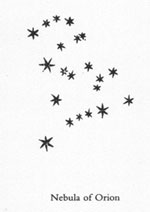
These early records have proved useful to modern astronomers. The Crab Nebula, M1, was found by Hubble and others to match the location of a bright daytime star recorded by Chinese astronomers in 1054 AD and is now known to be a supernova remnant. Other naked-eye observations such as that by Tycho Brahe in 1572 of a new star in Cassiopiea can also be matched with supernova remnants.
The introduction of the telescope for astronomy by Galileo led to a dramatic increase in observations and records. The drawing at right from his book Sidereus nuncius shows a region near the head of Orion near the star 39 Lam Ori. This nebual is now known as Collinder 69. The realisation that many more stars existed than were visible with the naked eye prompted the development of better and larger telescopes. Careful observation allowed skill observers to draw exquisite maps of the Moon and planets. Engraved plates allowed charts and drawings to be published and disseminated to a wider audience.
William Herschel, discoverer of the planet Uranus, attempted to map the shape of the Milky Way by counting and plotting stars using his newly built 20 foot long reflector with an 18 inch mirror. His map can be seen below. Herschel's systematic attempts at classifying celestial objects together with his development of larger telescopes had a significant long-lasting influence. His observations of nebulae, fuzzy cloud-like objects, ignited passionate debate as to whether they were stars forming or some other phenomena. The resolution of this argument, however, would only come in the twentieth century with the application of photography on large reflecting telescopes.
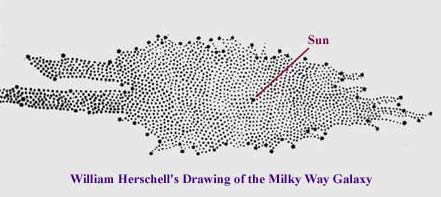
Photography in Astronomy
The earliest known photograph of an astronomical object, the Moon, was made by J. W. Draper in 1840. This was followed five years later by Foucault and Fizeau photographing the Sun from Paris. These early photographs were made using the daguerreotype process, a difficult and slow method using silver-coated copper plates. The long exposure times of about one minute required even for portrait photographs meant that any astronomical use was limited to only the very brightest objects.
Sunspots were photographed by the amateur astronomer W. De la Rue using the new, faster "wet collodion" process in 1858. This technique still required a photographer to sensitise their own plates and expose them shortly after before they could dry out.
The invention of the dry gelatine emulsion in in the late 1870s finally provided a safe, convenient method for photography. Its greater sensitivity allowed Jansen and Lockyer to photograph the spectral lines in the Sun's chromosphere and discover the element Helium. It was not isolated in a laboratory until 1895. The other key event in early astronomical photography was the photographs of the Great Nebula in Orion, M42, taken by the British amateur astronomer, Ainslee Common. His exposures lasted up to one hour and revealed stars that could not be seen by visual observation through a telescope. Photography became established as an essential tool of astronomers and led to a wealth of new discoveries.
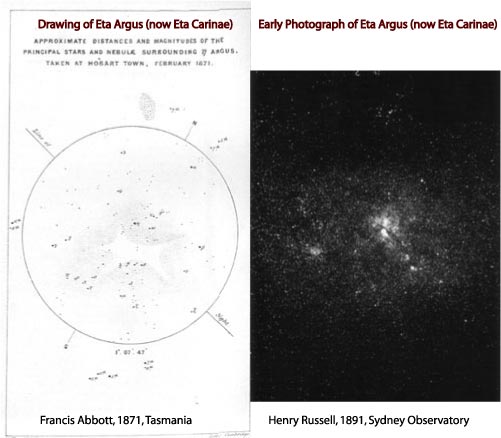
Astronomical photographic techniques continued to improve over the following century. As telescopes became larger they became much more sensitive. Observers such as Edwin Hubble using the Hooker 100 inch reflector on Mt Wilson was able to photographically record spectra of faint galaxies by making long exposures, sometimes over more than one night. His work led to the discovery of the expanding Universe and a resolution of the galaxy "island universe" debate.
Post-World War Two specialised Schmidt telescopes, large purpose-built photographic instruments with wide fields of view such as that at Siding Spring were used to photograph the night sky systematically at two or three wavebands. This work was carried out by observatories in the northern and southern hemispheres to produce a whole sky survey. This survey has since been digitised and can be viewed online as the Digitized Sky Survey in red and blue at SkyView.
Astrophotography reached its peak in the 1970s and 1980s. Techniques such as unsharp masking and photographic amplification used by people such as David Malin at the AAO allowed ever finer detail to be resolved. Three black and white exposures through cyan, yellow and magenta, cyan and magenta filters can be combined to produce stunning colour images such as the one of η Carinae below. Publication of these images did much to excite the public about astronomy. Whilst still valuable for professionals, most professional astrophotographs were taken as black and white images, not colour.
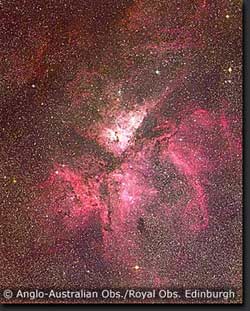
Photographic Technology
Photography works due to a photochemical reaction between incident light (photons) and the emulsion or film the photons land on. In professional astronomy the emulsion is normally on a glass plate rather than on more flexible acetate or polyester film. Glass plates do not are more stable than early generations of cellulose nitrate and acetate-based film and are more rigid so cannot wrinkle like film. This is essential for accurate astrometric measurements. Eastman Kodak developed emulsions such as IIIaJ, specifically for professional astronomical use. In astrophotography, the telescope replaces the lens of a normal camera.
A photographic plate is coated with a photographic emulsion comprising small silver halide crystals suspended in gelatin. Eastman Kodak developed emulsions such as IIIaJ, specifically for professional astronomical use. Incident photons can be absorbed by electrons in the valence band of silver halide molecules. The subsequent movement of electrons into the conduction band creates positive holes in the valence band. Slight impurities in the silver halides act as traps, immobilising the electrons to prevent them recombining with holes. Silver ions can then be neutralised by these immobile electrons, forming silver atoms. These in turn then capture other conduction electrons and ions in turn. What starts as a single silver atom can grow to few hundred pure silver atoms within a silver halide crystal. These specks of silver act as catalysts during the developing process so that the surrounding silver halide is rapidly reduced to pure silver.
The photographic process is therefore a chemical reaction. In normal photography the image produced is a negative which then needs to be printed as a positive image. Astronomers tend to work directly with the negative images for several reasons; to reduce chances of further errors, to maximise the image quality and often because it is easier to pick out a faint black object on a clear or white background than vice versa. Some cruel people also suggest that astronomers' dandruff falling on a positive image could be mistaken for stars!
Advantages of Photography in Astronomy
- Wide Field of View. Schmidt telescopes can cover a wide field of view, the UK Schmidt Telescope for instance covers a 6° × 6° field on a single plate. A survey plate from such an instrument can contain many thousands of discrete sources such as star.
- Resolution: There are many millions of silver halide crystals on a single plate. A plate has far higher resolution than a CCD chip of the same area. Even a coarse-grained 35mm film has the equivalent of 25 million pixels whilst fine-grained astronomical emulsions have even more.
Disadvantages of Photography in Astronomy
- Low Quantum Efficiency: Quantum efficiency, QE, is a measure of how efficient a detector is at converting incident photons into a useful signal. Photographic emulsions have a low quantum efficiency, at best about 3% for the specialised astronomical emulsion IIIaJ. This means that of 100 photons that hit a plate, only three trigger a photochemical reaction that results in a silver atom forming.
- Long Exposure Times: These result directly from the low quantum efficiency of emulsions. The less, efficient, the longer the emulsion must be exposed to gather the faint light. This then reduces the number of exposures that can be made on any given night. It also introduces another problem that emulsions have - reciprocity failure.
- Reciprocity Failure: This refers to the fact that the "speed" of a photographic emulsion decreases with increasing exposure time. It thus becomes even less sensitive as a long exposure continues. More pronounced in colour than monochromatic emulsions it is one reason why professional astrophotography uses black and white emulsions.
- Non-Linear Colour Sensitivity: Most films and emulsions are more sensitive to blue light than longer wavelength (hence lower frequency and energy) red light. This tends to mean that hot blue sources appear brighter than true values and cool red sources less bright than actual values when photographed. Of course astronomers use filters and can adjust for this but it is a complicating factor.
- Hypersensitising and Developing: Hypersensitising involves baking a plate at a specified temperature then soaking it in Nitrogen gas then Hydrogen gas for several hours. This process significantly improves the sensitivity of the emulsion, sometimes up to a quantum efficiency of 10%, justifying the time, expense and risk. The problem is that this process requires careful planning as to when plates will be used as once hypersensitised they must be used and developed within a few hours. In general, astronomical plates should be developed soon after exposure, normally on the same night. This is another burden on the astronomer's time and also imposes the need for suitable dark room facilities and materials.
- Storage: Glass plates are fragile, heavy and take up space. They must be stored under cool, dry, dark conditions for long-term stability. This imposes costs on observatories.
- Digitisation of Plates: Given that plates are heavy and fragile they are not easily accessible to a wide range of users. Fortunately they can be scanned into a digital form using special machines such as SuperCOSMOS, a microdensitiometer in Edinburgh. Plate-scanning machines produce high resolution images but are expensive, slow and require expertise in their use.
- Cost & Availability of Plates: Individual plates are expensive (a 30 cm × 30 cm plate cost about US$100 in 1996) and can only be used once. Poor exposures or weather can ruin a plate. As the professional market for specialised astronomical emulsions is so small and with the rapid and widespread adoption of CCDs for professional astronomy, Eastman Kodak phased out production of emulsions such as IIIaJ in the late 1990s.
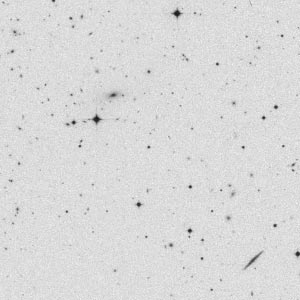
Nowadays most professional observatories have phased out their photographic programs and systems. Probably more than 98% of professional astronomy now involves the use of photoelectric detectors such as CCDs. These are discussed in the next section.
